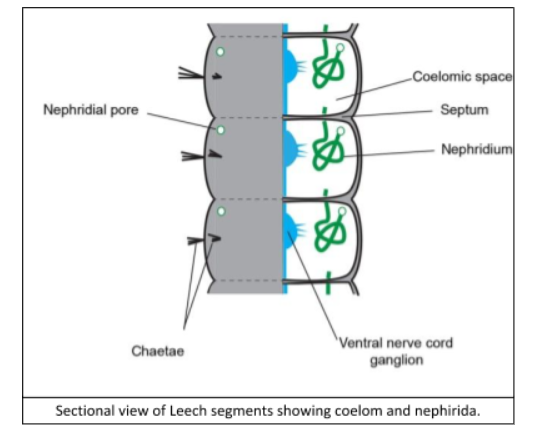
The characteristic feature of leech is:
(a) Nephridia
(b) Coelom
(c) Botryoidal tissue and hirudin
(d) All of the above
Answer
483.6k+ views
Hint: Leech is an Annelid worm belonging to class Hirudinea.
Complete answer:The scientific name of the most common Leech found in India is Hirudinaria granulosa.
It belongs to the class Hirudinea of the phylum Annelida.
We know that coelom first appeared in the Annelids and hence they are the first true coelomates. Coelom is the secondary body cavity lined on both sides by mesoderm.
So, it is obvious that leech also is a coelomate.
The excretory structures of leech are nephridia.
These are paired organs present in particular segments. In leech, there are approximately 17 pairs of nephridia.
The class of the leeches i.e. Hirudinea is so named because the members of this class secrete a peptide from their salivary gland- hirudin.
Hirudin is an anticoagulant agent. As leeches are hematophagous (feed on blood) in nature, such anticoagulants are required to keep the host’s blood from coagulating while they are being fed by the suckers. Botryoidal tissues invade coelom. The tissue consists of masses of cells which are excretory in function. The cells are of two types: granular botryoidal cells and flattened cells. Some of these contain brown pigments.
So, from the above explanation we can conclude that leeches have nephridia, coelom, botryoidal tissue and hirudin also. All of these are characteristic features of leech.
So, the correct option is ‘all of the above’.
Note:Besides Hirudinaria granulosa, there are several other leeches
commonly found such as Hirudo sp., Haemadipsa sp., Glossiphonia sp. etc.

Complete answer:The scientific name of the most common Leech found in India is Hirudinaria granulosa.
It belongs to the class Hirudinea of the phylum Annelida.
We know that coelom first appeared in the Annelids and hence they are the first true coelomates. Coelom is the secondary body cavity lined on both sides by mesoderm.
So, it is obvious that leech also is a coelomate.
The excretory structures of leech are nephridia.
These are paired organs present in particular segments. In leech, there are approximately 17 pairs of nephridia.
The class of the leeches i.e. Hirudinea is so named because the members of this class secrete a peptide from their salivary gland- hirudin.
Hirudin is an anticoagulant agent. As leeches are hematophagous (feed on blood) in nature, such anticoagulants are required to keep the host’s blood from coagulating while they are being fed by the suckers. Botryoidal tissues invade coelom. The tissue consists of masses of cells which are excretory in function. The cells are of two types: granular botryoidal cells and flattened cells. Some of these contain brown pigments.
So, from the above explanation we can conclude that leeches have nephridia, coelom, botryoidal tissue and hirudin also. All of these are characteristic features of leech.
So, the correct option is ‘all of the above’.
Note:Besides Hirudinaria granulosa, there are several other leeches
commonly found such as Hirudo sp., Haemadipsa sp., Glossiphonia sp. etc.

Recently Updated Pages
Master Class 11 Accountancy: Engaging Questions & Answers for Success

Glucose when reduced with HI and red Phosphorus gives class 11 chemistry CBSE

The highest possible oxidation states of Uranium and class 11 chemistry CBSE

Find the value of x if the mode of the following data class 11 maths CBSE

Which of the following can be used in the Friedel Crafts class 11 chemistry CBSE

A sphere of mass 40 kg is attracted by a second sphere class 11 physics CBSE

Trending doubts
10 examples of friction in our daily life

Difference Between Prokaryotic Cells and Eukaryotic Cells

One Metric ton is equal to kg A 10000 B 1000 C 100 class 11 physics CBSE

State and prove Bernoullis theorem class 11 physics CBSE

What organs are located on the left side of your body class 11 biology CBSE

Define least count of vernier callipers How do you class 11 physics CBSE




